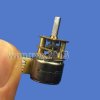You are using an out of date browser. It may not display this or other websites correctly.
You should upgrade or use an alternative browser.
You should upgrade or use an alternative browser.
Miniature Motor Question
- Thread starter Madman
- Start date
ntpntpntp
Registered
I don't believe so. Stepper motors need to be driven by specific electronics.
There are plenty of straight forward DC motors with gearboxes like that on ebay etc. Depends what you need it for?

There are plenty of straight forward DC motors with gearboxes like that on ebay etc. Depends what you need it for?
DC 6v 30rpm N20 Micro Speed Reduction Gear DC Motor With Metal Gearbox Wheel Hot for sale | eBay
Find many great new & used options and get the best deals for DC 6v 30rpm N20 Micro Speed Reduction Gear DC Motor With Metal Gearbox Wheel Hot at the best online prices at eBay! Free delivery for many products!
www.ebay.co.uk

What the others have said..
Stepper motors are used in things like computer controlled routers, 3D printers, and (flat-bed) plotters..
Special electronics is used to drive the motor is small 'steps', and they are designed to have very little backlash and can be held in position with great precision and force.
For the latter, they tend to use quite a bit of power.
By telling the electronics (a stepper-motor driver) to step continuously, you can get continuous rotary motion. The problem comes when you want to run slowly, as the motor 'steps' at an ever slower rate, until you notice the motion is a series of small discrete 'jerks'.
Hope that helps?
PhilP.
Stepper motors are used in things like computer controlled routers, 3D printers, and (flat-bed) plotters..
Special electronics is used to drive the motor is small 'steps', and they are designed to have very little backlash and can be held in position with great precision and force.
For the latter, they tend to use quite a bit of power.
By telling the electronics (a stepper-motor driver) to step continuously, you can get continuous rotary motion. The problem comes when you want to run slowly, as the motor 'steps' at an ever slower rate, until you notice the motion is a series of small discrete 'jerks'.
Hope that helps?
PhilP.
Greg Elmassian
Guest
Actually stepper motors can rotate continuously.
I'd stick with stepper motors move in discrete increments/steps, powered by a controller.
Conventional motors are designed to move in continuous rotation.
(it used to be that steppers were the kings of positioning, but they have been overtaken in the most part with a servo motor (high torque) with an encoder disk to tell "where you are".... steppers have to start from a "reset point" and "count" their way to an absolute position.
Greg
I'd stick with stepper motors move in discrete increments/steps, powered by a controller.
Conventional motors are designed to move in continuous rotation.
(it used to be that steppers were the kings of positioning, but they have been overtaken in the most part with a servo motor (high torque) with an encoder disk to tell "where you are".... steppers have to start from a "reset point" and "count" their way to an absolute position.
Greg
D
Deleted member 4232
Guest
Moved
Last edited by a moderator:
Madman
Registered
As in continuous rotation with the ability of Forward & Reverse as in a conventional DC motor, well the answer to that is yes, although it does involve some electronic skulduggery.......
The following is a very old circuit, used a variation of this way back in 2000, to operate a CD Turntable for a 7mm NGA layout, no proportional speed control, just forward and reverse, speed was irrelevant as the gearing was so low, component selection is critical, especially the values of the resistors, each one does involve a manual check with a multi meter to achieve exact values, the manual switches were replaced with micro switches to act as limit switches.
Then as is 2006 DCC arrived, all the analogue circuitry was assigned to the bin of history!
View attachment 254150
So to the present day....

US $10.14 50% OFF|GA12BY15 DC 5V 30RPM 15RPM 5RPM Stepper Motor Threaded Shaft Gear Motor with All Metal Gearbox|Stepper Motor| - AliExpress
Smarter Shopping, Better Living! Aliexpress.comwww.aliexpress.com
Tad more sophistication with one of these..............

Stepper Motor Driver 2-phase 4-wire Controller Speed Adjustable with Remote - AliExpress 13
Smarter Shopping, Better Living! Aliexpress.comwww.aliexpress.com
As ever there are numerous options and choices if going down the micro controller route............
Thank you for your response. However, there's way too much in the way of electrons for me wee brain to absorb. I have found similar miniature gear motors to fill my need. But none, so far as compact as the one I pictured. But wait ! I just viewed the two items you linked, from AliExpress. I must look deeper to absorb their possibilities. Thanks again
Last edited:


